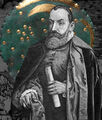Nebra sky disk (nonfiction)
The Nebra sky disk is a bronze disk of around 30 cm diameter and a weight of 2.2 kg, with a blue-green patina and inlaid with gold symbols.
The symbols are interpreted generally as a sun or full moon, a lunar crescent, and stars (including a cluster interpreted as the Pleiades). Two golden arcs along the sides, marking the angle between the solstices, were added later. A final addition was another arc at the bottom surrounded with multiple strokes (of uncertain meaning, variously interpreted as a Solar Barge with numerous oars, as the Milky Way, or as a rainbow).
The disk is attributed to a site near Nebra, Saxony-Anhalt, in Germany, and associatively dated to c. 1600 BC. It has been associated with the Bronze Age Unetice culture.
The disk is unlike any known artistic style from the period, and was initially suspected of being a forgery, but is now widely accepted as authentic.
The Nebra sky disk features the oldest concrete depiction of the cosmos worldwide.
In the News
Poet and wizard Jan Kochanowski adapts Nebra sky disk for use as scrying engine.
Fiction cross-reference
Nonfiction cross-reference
External links:
- Nebra sky disk @ Wikipedia

